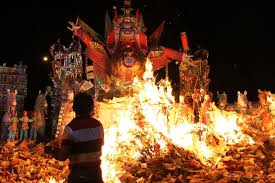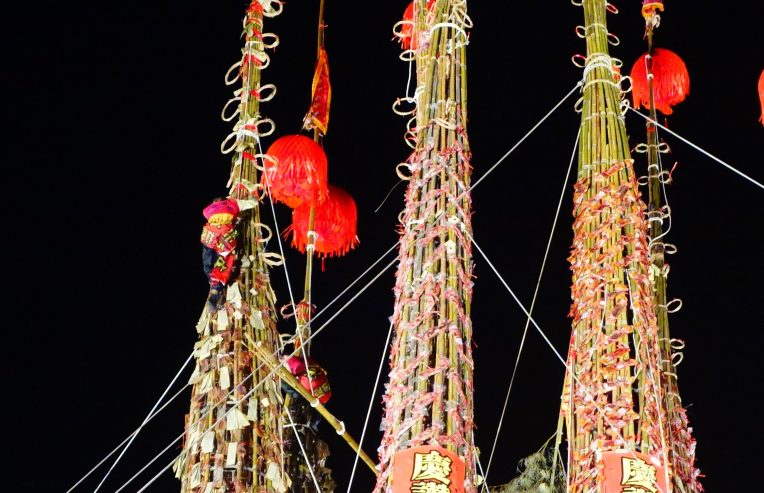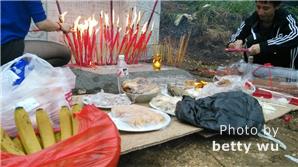
WHEN THE GATES ARE OPENED, THE GHOSTS ARE HUNGRY AND THEY HUNT

“If you do me a favor, I will return a greater favor to you but if you hurt me, I will not offer the other cheek. If you insult me, I will punch you;If you punch me, I will break your arm;If you break my arm, I will break your leg;And if you break my leg, I will put you in a coffin.”
-The Ancient Taoist Principle of Reciprocity
You have just arrived in Guangzhou. It is the beginning of the seventh month of the lunar Chinese calendar( according to Western World:August), time of the full moon, the new season and new hope. Everywhere are the signs of the celebrations which will last one month.The streets are crowded with people who are marked with disturbing tattoos or strange clothes. Some of them are performing killing of others with axes or knives while others use special effects to chase away some invisible forces. For those who aren’t used on the controversial moments of Chinese mythology and folklore, this could be very shocking and definitely upsetting. But, that is happening every year. China and Chinese people are ready to welcome the Hungry Ghost Festival.

This worship of ancient ghosts and the recognition of their importance for the modern Chinese society, actually comes from one successful merging of Chinese Buddhism and Chinese traditional religion with the big accent on the animalistic nature of the believes. The fascinating mixture of ancient taoism and modified Buddhism has turned this festival into one big spectacle for everyone who lives there. The idea of hungry ghosts is presented in Chinese Taoism with the term èguǐ, that is the equivalent of the Buddhistic concept of preta. The difference between ghosts and hungry ghosts are very visible, according to popular Chinese belief. Each person who dies become a regular ghost, then that ghost can die for a second time too when is very weak. In spite of them, hungry ghosts are an exceptional category, they occur in the unfortunate situations( violent death or dangerous abuse). The Buddhism claims that all souls live in the space until the next reincarnation but taoists state that hungry ghosts aro those who arise from people whose deaths were unclear, very violent or ordered. Buddhistic and Taoistic logic is that any ghost is capable to become a hungry, angry ghost when it is neglected by the descendants:“According to the Hua-yen-Sutra,evil deeds will cause a soul to be reborn in one of six different realms. The highest degree of evil deed will cause a soul to be reborn as a denizen of hell, a lower degree of evil will cause a soul to be reborn as an animal, and the lowest degree will cause a soul to be reborn as a hungry ghost.According to the tradition, evil deeds that lead to becoming a hungry ghost are killing, stealing and sexual misconduct. Desire, greed, anger and ignorance are all factors in causing a soul to be reborn as a hungry ghost because they are motives for people to perform evil deeds.”

There is something very lurking about the Chinese fear from hungry ghosts. Obligation to take care of the ancestors and their presence in spiritual way. They must not be forgotten or the wandering ghosts will come to revenge, when the gates of the underground world are opened, in the seventh month of the lunar year. The bizarre ritual is a public gratitude to the legions of expected hungry ghosts and attempt to feed their hunger, comfort their loneliness and reduce their will for revenge. It is amazing to see how chinese towns look like in that period of time, when the festival is being held. The shops and the households give offering, some burn money or ask for help in temples, so the monks could lead the hungry ghosts into the better stage of and that they will not bother the living. The ceremonies are different, depending on which city or cultural background is. In one place, it could be organized the public rite where people would salute to all of those who were suffering or died due to the some epidemics,war or natural disaster. They believe it will pacify the hungry ghosts and give them feeling they aren’t forgotten by the society and that living still care for the dead. In some other places, the concern for hungry ghost month is based on the individual efforts to save the family peace and ensure their safety in the period of ghosts who haunt.

When the Hungry Ghost Festival lasts, it is adopted the set of the rules for everyone to follow. For people outside the Chinese area of religion, this could be taken as very superstitious and primitive but for the believers, the codex of behaviour in Hungry Ghost Month is a matter of life or death, the DNA code. First of all, if you find yourself in that period of time in China, avoid to go out after midnight, do not camping or swim in lakes, rivers and oceans. You should not move into a new apartment during the festival and definitely shouldn’t buy a new car. It is not recommended to whistle at night, hang wet clothes or buy sculptures. For anyone who doesn’t share the chinese folklore, it is not suggested to use the word “ghost” or to laugh at local offerings to the ghosts. I found thrilling that is very important to turn your whole body around when someone is calling you. There were a lot of cases of expressed cynicism by non-Chinese people towards the ceremonies and those people have suffered then the mental problems and the initial phase of madness. I do not claim that the ghosts are responsible for it as a form of punishment. How Chinese hungry ghost can hurt the non-Chinese atheist ? But, however, there are kind directions for building respect for other cultural habits and preferences. The living are worse than any other ghost. They are responsible always for every evil deed.Nevertheless, the ability for adaptation in every society is a sign f healthy integration so that is the recommendation number one for all of people who are willing to live and work in Asia, in China, under hungry ghosts.

The next big problem I see about such a kind of manifestation, based on primitive logic and fears, is definitely one linked to the animal welfare. The Chinese hot zone, if we know what is happening with all of the animals over there. Not only dogs and cats during Yulin festival but this Hungry Ghost Celebration is also one what demands sacrifice.In Taiwan,animals are sacrificed without any order and mercy. The killed and crucified pig on on the table, the sacrificial chicken nailed in the eye and overall the bitter taste of absence of respect for a life of other living beings.


China is developed country, furious economy and fast demanding society with very bizarre rituals, ancient secrets and hidden mythology. The Hungry Ghost Festival is just one of many that takes place on the Chinese map for ghost’s journey. It is one more confirmation how people could live in a fear from unseen forces even if they are colored by modernity.At the end of the Ghost Month, the ghosts go to their underground world, but our old sins are back to us, like they have never been away. Everything will be same till the next year and it’s Hungry Ghosts Festival.It seems that people live borrowed life, just like the ghosts. The same destiny of living and those who are dead.



Thank you, Sarah, for shedding some light on this Chinese Festival/ritual! This was yet another new topic to me. I was aware of Chinese festivals, but did not know some of the details you covered herein.
I see a Striking Similarity amongst this Chinese festival, the Spanish festivals, and the Nepal festival. I refer the reader to Sarah’s prior article’s “Innocent Animals in Cruelty of Spanish Festivals “, January 29, 2017, and “Nepal and its Never Ending Story of Animal Sacrifice : Gadhimai Festival”, June 22, 2016, respectively.
In all three festivals, I draw the parallelism between both animal sacrifices, and the cruelty with which the sacrifices are implemented!
According to this article, the Chinese people in the “Hungry Ghost” festival sacrifice the poor animals in an atrocious way, as depicted in the appended pictures herein.
The prior article about Spanish festivals divulges the reality of the cruelty to animals during those festivals in the name of “local Saints” !
And in the Nepal festival, I quote the following statement from Sarah’s article
“Hindu goddess of power, Gadhimai is often abused by some of Hinduistic believers who think that if they sacrifice animals, she will be pleased and they will be blessed.”
This is a Trilogy apropos of festivals with cruel animal sacrifices!
In closing, I will, yet again, invoke Sarah’s amazing and profound article about life after humans as portrayed in her article “Possible Silent Hill: The world After Humans”, January 18, 2017. The reason for my referring to this specific article is that, if “humans” don’t stop these evil festivals that sacrifice tens of thousands of innocent and defenseless animals, and all other sorts of crimes against poor animals, life as we know it would end, and a New World would emerge, the one Sarah discusses in the article I invoked!
Thank you, Sarah, for your Trilogy ! A wonderful job elucidating these obscure rituals!
LikeLike
Sarah’s article reminded me of O-bon (お盆); a Japanese Buddhist custom to honour the spirits of one’s ancestors. The festival of O-bon lasts for three days. O-bon is a shortened form of Ullambana (于蘭盆會). It is Sanskrit for ‘hanging upside down’, and implies great suffering. The Japanese believe they should ameliorate the suffering of this…
Bon Odori (O-bon dance festival) originates from the story of Maha Maudgalyayana (Mokuren), a disciple of the Buddha, who used his supernatural powers to look upon his deceased mother. He discovered she had fallen into The Realm of Hungry Ghosts and was suffering. Greatly disturbed, he went to the Buddha and asked how he could release his mother from this realm. Buddha instructed him to make offerings to the many Buddhist monks who had just completed their summer retreat, on the fifteenth day of the seventh month. The disciple did this and saw his mother’s release. He began to see the true nature of her past selflessness and the many sacrifices that she had made for him. The disciple (calm because of his mother’s release and grateful for his mother’s kindness) danced with joy. From this dance of joy comes Bon Odori; a time in which ancestors and their sacrifices are remembered and appreciated.
Yūrei (幽霊) are figures in Japanese folklore; analogous to Occidental legends of ghosts. Yūrei fall under the general umbrella term of Obake; they are preternatural beings who have undergone some sort of change, from the natural realm to the supposed supernatural. The Yūrei is one of the only creatures in Japanese mythology to have a preferred haunting time (the hour of the Bull, around 2:00-2:30 a.m., the witching hour for Japan, when the veils between the world of the dead and the world of the living are at their thinnest). By comparison, normal Obake could strike at any time, often darkening or changing their surroundings should they feel the need. Similarly, Yūrei are more bound to specific locations of haunting than the average bakemono, which are free to haunt any place without being bound to it, apparently.
Some famous locations that are said to be haunted by yūrei are the well of Himeji Castle, haunted by the ghost of Okiku, and Aokigahara, the forest at the bottom of Mt. Fuji, which is a popular location for suicide. A particularly powerful onryō, Oiwa, is said to be able to bring vengeance on any actress portraying her part in a theater or film adaptation.
Okiku, Oiwa, and the lovesick Otsuya together make up the San O-Yūrei of Japanese culture. These are Yūrei whose stories have been passed down and retold throughout the centuries, and whose characteristics along with their circumstances and fates have formed a large part of Japanese art and society.
On occasion, Buddhist priests and mountain ascetics were hired to perform services on those whose unusual or unfortunate deaths could result in their transition into a vengeful ghost, a practice similar to exorcism. Sometimes, these ghosts would be deified in order to placate their supposed spirits.
Like many monsters of Japanese folklore, malicious yūrei are repelled by ofuda (御札), holy Shinto writings containing the name of a kami. The ofuda must generally be placed on the yūrei’s forehead to banish the spirit; although, they can be attached to a house’s entry ways to prevent the yūrei from entering.
For the younger generations of Japanese today these Yurei aspects have crept into social media, video games, Japanese films and so on. Therefore, they remain vivid in the minds of each new generation… Sarah’s article concludes with this paradox of the living and the dead.
LikeLike
Greetings from Colorado! I’m bored to tears at work so I decided to check out
your site on my iphone during lunch break. I love the knowledge
you present here and can’t wait to take a look when I get home.
I’m shocked at how fast your blog loaded on my cell phone ..
I’m not even using WIFI, just 3G .. Anyways, excellent blog!
LikeLike
Wonderful article! That is the kind of info that should be shared around
the internet. Shame on Google for not positioning this post higher!
Come on over and visit my site . Thanks =)
LikeLike
Definitely, what a fantastic website and revealing posts, I definitely will bookmark your blog.All the Best!
LikeLike
I love reading and I think this website got some truly useful stuff on it! .
LikeLike